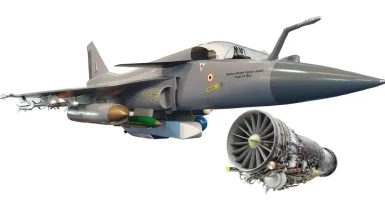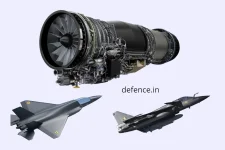- Views: 2K
- Replies: 15
India's advanced indigenous Light Combat Aircraft (LCA), the Tejas Mk2, has been newly depicted with an impressive suite of modern armaments, signalling a major step forward in the nation's self-sufficiency in defence technology. This updated configuration equips the aircraft for a wide range of operations, including precise attacks and air dominance.
The newly integrated weaponry features the Tara Precision Guided Munition (PGM), Rudram-II anti-radiation missile, Astra Mk1 beyond-visual-range air-to-air missile, ASRAAM short-range air-to-air missile, and a Quad Rack for the Smart Anti-Airfield Weapon (SAAW), highlighting the aircraft's significantly boosted combat potential.
The Tejas Mk2, a project of the Aeronautical Development Agency (ADA) with manufacturing by Hindustan Aeronautics Limited (HAL), represents a significant upgrade from the earlier Tejas Mk1. Key enhancements include improved aerodynamic design, a more powerful General Electric F414 engine, and a modernised avionics system.
Recent visual representations of the Tejas Mk2 confirm its capacity to carry a versatile combination of advanced weapons suitable for both air-to-air combat and air-to-ground attacks:
- Tara PGM (Precision Guided Munition): Developed by India’s Defence Research and Development Organisation (DRDO), the Tara PGM is a new-generation guided bomb. It is engineered for high-precision targeting of valuable assets like fortified bunkers and critical enemy infrastructure, maintaining accuracy even in challenging weather conditions. Its inclusion on the Tejas Mk2 emphasizes the aircraft's capability for surgical strike operations.
- Rudram-II: This advanced anti-radiation missile, an improved version of the Rudram-I, is designed for the suppression of enemy air defences (SEAD). The Rudram-II can target enemy radar systems and communication hubs, thereby enabling the Tejas Mk2 to neutralize threats before conducting deeper penetration missions. This makes it an essential tool for operating in heavily defended airspace.
- Astra Mk1: The Astra Mk1 is India's domestically developed beyond-visual-range air-to-air missile (BVRAAM), also a product of DRDO. With an effective range exceeding 100 kilometres, it gives the Tejas Mk2 a strong capability to engage hostile aircraft from significant distances, which is crucial for achieving air superiority during aerial combat and interception tasks.
- ASRAAM (Advanced Short Range Air-to-Air Missile): Originating from the United Kingdom, the ASRAAM is a highly manoeuvrable, infrared-guided missile intended for close-range air combat. Its integration into the Tejas Mk2's arsenal enhances the jet's effectiveness against fast-moving targets in within-visual-range encounters, providing a balanced air-to-air capability alongside the Astra Mk1.
- Quad Rack for SAAW (Smart Anti-Airfield Weapon): The SAAW, another DRDO innovation, is a precision-guided glide bomb created to destroy enemy runways, aircraft shelters, and other airfield facilities. The incorporation of a Quad Rack system allows the Tejas Mk2 to carry four SAAW bombs at once, substantially increasing its destructive power and operational efficiency when attacking well-protected targets.
A strong emphasis on indigenous development means that most of these armaments are produced within India, thereby reducing dependence on international suppliers and strengthening the nation's defence manufacturing sector.
The Tejas Mk2, with its increased weapon carrying capacity and ability to perform multiple roles, is anticipated to replace older aircraft such as the MiG-21s and operate alongside more advanced fighters like the Rafale and Su-30 MKI in the IAF inventory.
The aircraft's capacity to deploy a mix of air-to-air and air-to-ground munitions makes it a flexible asset for diverse operational needs, ranging from counter-insurgency support to large-scale conflicts. The Quad Rack for the SAAW, in particular, greatly boosts its power in disabling enemy airfields, a vital function in potential conflicts.
This unveiling of the Tejas Mk2 equipped with its new weapons package demonstrates India's advancing expertise in aerospace and defence technology. As the aircraft progresses towards its expected induction into service in the late 2020s, the IAF anticipates a capable, modern fighter jet that meets its operational requirements while also bolstering the "Make in India" initiative.
The new depictions not only highlight the aircraft's enhanced capabilities but also serve as a positive indicator of India's dedication to developing a self-reliant and technologically advanced air force.


